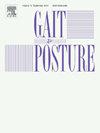认知运动干扰对平衡能力差的青少年行走能力的影响。
IF 2.2
3区 医学
Q3 NEUROSCIENCES
引用次数: 0
摘要
背景:据报道,运动能力(MC)下降的儿童与发育正常的同龄人相比,在行走表现上存在差异,尽管结果并不一致:研究问题:在认知-运动干扰条件下,平衡能力下降对青春期男孩和女孩的行走能力有何影响?这项横断面研究使用儿童运动评估电池第 2 版对 13-14 岁青少年的运动能力进行评估,并根据放置在估计质心上方的惯性测量装置得出的步态参数评估步行表现。每位受试者以自己选择的速度进行了两次 10 米直线行走。其中包括一次无干扰行走和一次认知运动干扰行走(大声背诵字母表中的交替字母)。采用双向混合方差分析来评估是否存在显著的交互作用:共有 365 名青少年(低平衡力 = 58 人,典型平衡力 = 307 人)参加了这项研究(男生 = 204 人,女生 = 161 人)。男生(F(1,195) = 5.23, p= 0.02, ηp2 = 0.03)和女生(F(1,154) = 4.05, p= 0.046, ηp2 = 0.03)的步行速度在 MC 组和步行条件之间存在显著的交互作用。与单任务步行相比,在认知-运动干扰条件下,平衡能力差的男女儿童比发育正常的同龄儿童更大程度地降低了步行速度。此外,与发育正常的同龄人相比,平衡能力差的男孩步长变异性增加(F(1,198)= 4.40,p= 0.037,ηp2= 0.02):重要意义:平衡能力差的青少年表示行走能力有所改变。我们的数据有助于更好地理解平衡与步态之间的关系,并有助于制定干预措施,为有困难的青少年提供支持。本文章由计算机程序翻译,如有差异,请以英文原文为准。
The effects of cognitive-motor interference on walking performance in adolescents with low balance
Background
Children with reduced motor competence (MC) have reported differences in their walking performance when compared to their typically developed peers, albeit, with inconsistent results.
Research questions:
What is the effect of reduced balance on walking performance in adolescent boys and girls under cognitive-motor interference conditions?
Methods
This cross-sectional study assessed motor competence, in adolescents aged 13–14 years, using the Movement Assessment Battery for Children 2nd edition and walking performance from gait parameters derived from an inertial measurement unit placed over the estimated centre of mass. Each participant performed two 10 m straight-line walks at their self-selected speed. These consisted of a walk with no distractions and a cognitive-motor interference walk (reciting the alternate letters of the alphabet out loud). A two-way mixed ANOVA was used to assess for significant interactions.
Results
365 adolescents, (low balance = 58, typical balance = 307) participated in this study (boys = 204, girls = 161). Significant interactions were reported between MC groups and walking condition for walking speed in boys (F(1,195) = 5.23, p= 0.02, ηp2 = 0.03) and girls (F(1,154) = 4.05, p= 0.046, ηp2 = 0.03). Both sexes with low balance reduced their walking speed to a greater extent than their typically developed peers under cognitive-motor interference conditions compared to the single-task walk. In addition, boys with low balance reported increased stride length variability (F(1,198)= 4.40, p= 0.037, ηp2= 0.02) compared to typically developed peers.
Significance
Adolescents with low balance report altered walking. Our data could support a better understanding of the relationship between balance and gait and may help the development of interventions to support those with difficulties.
求助全文
通过发布文献求助,成功后即可免费获取论文全文。
去求助
来源期刊

Gait & posture
医学-神经科学
CiteScore
4.70
自引率
12.50%
发文量
616
审稿时长
6 months
期刊介绍:
Gait & Posture is a vehicle for the publication of up-to-date basic and clinical research on all aspects of locomotion and balance.
The topics covered include: Techniques for the measurement of gait and posture, and the standardization of results presentation; Studies of normal and pathological gait; Treatment of gait and postural abnormalities; Biomechanical and theoretical approaches to gait and posture; Mathematical models of joint and muscle mechanics; Neurological and musculoskeletal function in gait and posture; The evolution of upright posture and bipedal locomotion; Adaptations of carrying loads, walking on uneven surfaces, climbing stairs etc; spinal biomechanics only if they are directly related to gait and/or posture and are of general interest to our readers; The effect of aging and development on gait and posture; Psychological and cultural aspects of gait; Patient education.
 求助内容:
求助内容: 应助结果提醒方式:
应助结果提醒方式:


